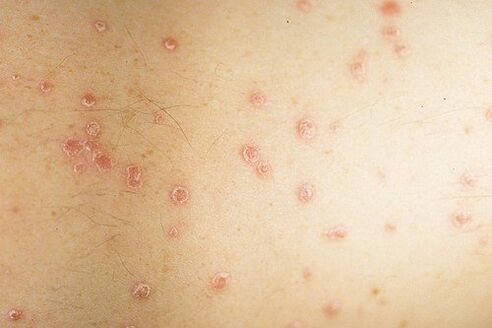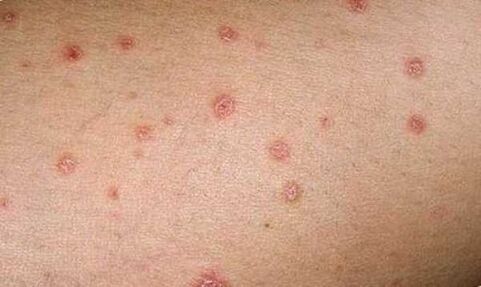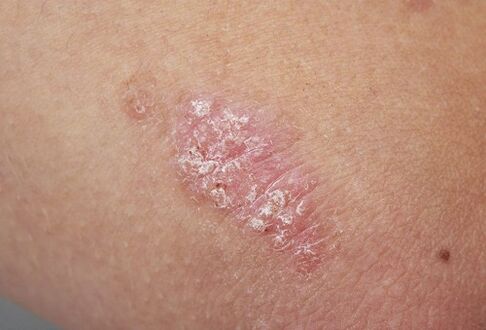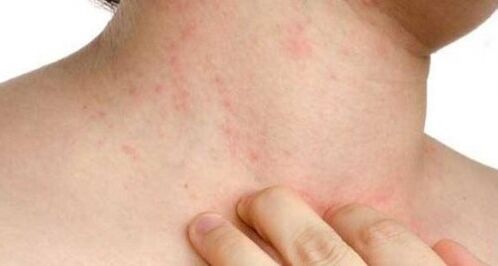Chronic illness lasts a long time, sometimes for years-the almost complete disappearance of pathological signs can be replaced by a period of relapse, and then the body is again covered with a rash. This is a hallmark of skin psoriasis. It is necessary to know everything about the disease, including what psoriasis looks like in its early stages, because the rapid detection and treatment of the disease depends on it.

The cause of the disease
The main factors in the development of this disease are genetic predisposition transmitted from parents and close relatives, and a weakened immune system, which is unable to cope with its function.
These are wounds on the skin that are not contagious, so don’t be afraid to get infected through close contact with a sick person. Another thing is when the disease causes an unpleasant, painful sensation and itching accompanied by scratches. Through microscopic lesions and damage to the epidermis, any infection quickly enters the bloodstream and a person becomes infected.
In medicine, there are many known causes that can cause disease:
- Pathology of endocrine organs, requires hormonal changes;
- Constant stress, experience and shock cause the same disruption;
- Improper diet, lack of nutrients, minerals and vitamins can provoke psoriasis;
- Low immunity, weak due to bad habits, lack of vitamin D3 and silicon, nervous shock, colds and frequent hypothermia;
- Poor living conditions and climate;
- Violation of metabolic processes, in particular, in the skin layer, because of what exactly the disease is in the form of an itchy rash.
Medication taken can also cause anomalies, if it has a long -term and strong effect, the body's immunological reaction to allergens can be an aggravating factor. And, of course, the onset of psoriasis is often associated with a previous infection that has not completely healed or has had serious complications.
The defeat of the disease is local and general in nature, when the human body represents a continuous crust of combined wounds. In this case, it is necessary to consider the stages of psoriasis, as they differ in their course and symptoms.
Type of disease according to the type of course
The disease develops cyclically - this is a gradual change and increase in special symptoms.

There are three main stages:
- Progressive psoriasisAre two main stages. During the first, the characteristic rash develops actively, which causes the patient an unpleasant burning sensation, pain, severe itching. As a result, normal appetite, disturbed sleep, a person is currently prone to irritability, depression, neurosis. The second stage is remission, restoration of normal appearance and condition of the epidermis, permanent pigmentation spots at the site of psoriatic lesions, slightly darker than normal skin color. The progressive stage is a typical clinical picture of chronic disease. When there is no treatment, the recovery period will be short and soon, the likelihood of pathology increases;
- The stage of psoriasis does not move- this is a stable condition of the patient, when the symptoms do not disappear, but new papules also do not appear. At the same time, the growth of existing spots, which begin to actively exfoliate, stops temporarily. Patients expect the hope that after exfoliation, the red plaques that arise on the skin will heal and disappear, but this does not happen - once one stratum corneum appears and the other until infinitum. At least when the psoriasis stage is immobile, the patient does not feel unbearable itching, which causes scratches and insomnia;
- Last rank- regression period. Over a period of time, a gradual decrease in plaque-like scabies occurs, the wound heals, a clean area of epidermis appears between them, until the rash disappears completely, only the remnants of pigmentation remain from the painful area.
Psoriasis has a long history. In some patients, complications most often occur in winter and autumn, while in others, sunlight affects the deterioration of the condition, however, there is a variant of off-season exacerbation, when relapses can occur at any time of year. In general, there are several cases of disease progression throughout the year.
To understand how psoriasis begins, it is necessary to consider its main symptoms.
Early stage: characteristic manifestations
Pathology almost always occurs suddenly, for no apparent reason, although, of course, it exists. The impulse can be the flu, stress at work, snack poisoning, or an allergic reaction.
Many are intrigued by how psoriasis manifests itself, because at first one might think of small reddish nodules that are spread in different parts of the body due to an allergic rash. And if it is a pustular appearance, then small bubbles with pus appear in the epidermis, which are easily confused with urticaria. Moreover, in some cases, the early stages are accompanied by itching. Therefore, the question of whether psoriasis is itchy at an early stage, with this type of skin lesion, can be answered affirmatively.
The main elements of the rash are flat and slightly elevated nodules that are pink or red in color; this inflammation has a surface layer where small dry scaly plates are located. Detailed examination showed that initially the stratum corneum was located at the center of the inflammatory focus, and then grew across the surface of the plaque.

The location of the rash varies - these are the inner and outer folds of the knee, elbow joint, the entire surface of the lower and upper legs, hands, palms and soles of the feet, groin, gluteal area, back, chest. Elements of the rash tend to appear on the auricle and behind it, covering the skin on the head under the hair, appearing on any part of the face, and sometimes on the genitals, especially in men.
The elements of the rash that spread throughout the body become growing with gray scabies in just two or three days. In medicine, this is called a form of disease.
After that, the growth of new wounds continues, after which they can merge and merge into a dense area. The pathological feature is that papules can also occur at the site of bruises, other injuries, if the disease begins to persist.
If the first appearance of inflammation is usually not accompanied by itching, with a progressive process, it becomes painful and then the patient should be treated with local hormonal drugs.
Launched psoriasis can lead patients to severe physical and mental conditions.
Plaque growth interferes with walking, sitting, and performing simple human actions. In addition, patients with this disease are prone to severe neurological and mental illness.
Some forms cause destruction of blood vessels, nerve endings, joints, psoriatic lesions can destroy bone tissue. Without treatment, a person can be brought to a disability, so you need to see a doctor if there are early manifestations of the disease.
Diagnostics and treatment
Prior to performing laboratory and instrumental examinations, physicians are faced with the task of obtaining a complete picture of patient complaints, examining the cause of the disease, and tracing the genetic link to the onset of pathology.
To determine the disease, there are specific functional tests. If there are three main elements (psoriatic trio), which are characterized by the presence of stearin spots, pink cell lining and bleeding caused by vascular damage, then an accurate diagnosis can already be made.

In the future, procedures such as:
- Biopsy of samples of affected skin tissue;
- Bacteriological culture to determine infection at the focus of inflammation;
- Clinical blood tests for leukocyte concentrations;
- Immunological testing for allergic predisposition;
- X-rays, ultrasound, determine the condition of internal organs, articular cavities, bones;
- Differential diagnosis helps rule out diseases such as syphilis, seborrheic eczema, pink lichen, rheumatism, and other disorders with similar symptoms.
In most cases, it is impossible to get rid of the pathology permanently, but earlier treatment can help reduce the number and quality of relapses, up to a long period of regression.
Complex treatments offer:
- Conservative therapy with steroidal and non -steroidal drugs, psychotropic drugs that relieve the patient’s depression;
- Also, funds are prescribed to reduce allergic reactions of the immune system, which allows you to get rid of edema, itching, and reduce the course of inflammatory processes;
- Hormone medications are prescribed to suppress inflammation and relieve pain in severe forms;
- Without fail, patients must take vitamin products that help boost the body’s defenses;
- Ointments and creams applied topically to relieve the well-being of patients are based on medicinal ingredients, and sometimes hormones.
People suffering from chronic skin diseases need to lead a healthy lifestyle, abandon inappropriate diets, and perform daily water procedures to avoid complications of the disease. And of course, for a successful recovery, you need to see a doctor as early as possible.























